One of London’s longest office blocks has recently been undergoing a bit of a clean up and last week, I was able to have a look around the spartan interior before the new tenants move in.
The building is the first release in a wave of new office blocks that will replace the tired 1960s architecture running along Victoria Street between now and 2018. The first building though is not a replacement, but a cleaning up of an existing, and in some ways quite interesting building of its time.
What is now known as 123 Victoria Street (formerly Ashdown House) is one half of two buildings that run almost all the way from Victoria station to the Army & Navy Store, with a break in the middle for Westminster Cathedral.
From the outside, the most dramatic changes vary depending on which side of the road you walk along – as from the other side, the dramatic change is in the glass. Gone is the old brown tinted glass in favour of a slightly blue-tinted but otherwise transparent façade. The new glass is as solar efficient as the old brown tint glass which so strongly defined office blocks of that era.
If walking next to the building though, under its covered walkway, the concrete roof has been replaced with a cleaner design and lit again. It’s not — in my opinion — that the old concrete ceiling was bad, just that it was not properly maintained. This lack of maintenance being the main curse of 1960s buildings which age badly when left untended.
The other major difference though is that the side facing the Cathedral plaza is now glazed and has an entrance to the offices above. It used to be a fire escape.
The main entrance however is still at the other end of the building – the aim with two entrances is to create two addresses and let tenants split the building up as needed. It could be a very long and narrow office space otherwise. Great for zooming along on a pedal scooter!
Inside the main entrance, there is a large, but not oppressively so foyer, with some nice detailing. The lifts are of the modern sort which require you to select which floor you need before getting in – which always throws me for a moment.
At the moment, the floors are empty, which actually looks really nice, if in an artificial way as they will soon be covered in carpets, desks and computers. And coffee stains.
The lower floors also have an atrium area to lighten up the area the wider footprint which would otherwise be quite dark in one corner next to the neighbouring buildings.
The company pondered demolishing the building and putting up a replacement, but that would have pushed back the completion date to 2014 at least, and would have pushed up the costs – leading to higher rents.
Land Securities — for it is they who are rebuilding the area — went for the cheaper option so that they could have a range of tenants that can pay decent, but not outrageous rents. More modern office blocks tend to be better for larger companies, but also cost more to manage.
The other advantage is that the retail space at ground level will be offered at a decent rate to encourage a wider selection of shops away from the generic high-street chains. This is enlightened self-interest, as better shopping makes it easier to rent out the more expensive office blocks being built in the area.
This is part of an overall masterplan to migrate the Victoria area from one dominated by civil servants to yet another cluster of tech/fashion industries.
Interestingly, the Cathedral Plaza appeared after the Cathedral was built – when the Church of England which owned the land along Victoria Street arranged the construction of the two office blocks lining the street today – and in doing so, left open the space in front of the Cathedral to create the plaza in the 1970s.
The replacement of the windows with modern glass almost caused a problem with the plaza as some locals complained that having one side with clean blue glass, and the other side retaining its 1970s brown tint would ruin the symmetry of the space. Until it was noted that the buildings are not actually symmetrical.
For me though, a key downside of floor to ceiling windows is that once tenants move in, they can end up looking very messy from the outside. A nearby building has turned the glass windows into areas to pile up paper and the detritus of office life – and from the outside, it looks horrid.
I tend to prefer an office with a solid wall up to desk height, then windows – so that the wall hides the naughty secrets from being seen by outsiders.
That aside, if the people inside can keep the windows clear of junk – then the switch from brown to blue glass has really helped to make the building feel less oppressive and actually highlights the physical structure and cuboid shapes.
There is a slightly cheesy video on their official website with people jumping around the roof of the building in a manner that I am never allowed to come close to when I am invited on site. Not that I would jump around like that anyway.
And for architectural model fans, there is a model of the entire Victoria area in the Land Securities marketing suite, with their development picked out in pink – showing just how much of the area is to be redeveloped.
The first tenants – a shoe designer – will be moving in to the building in the New Year.

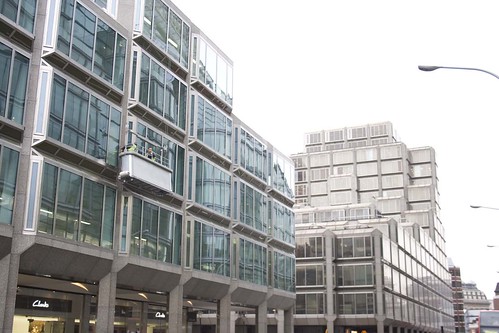
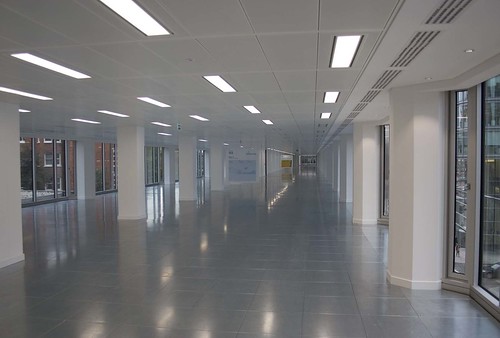

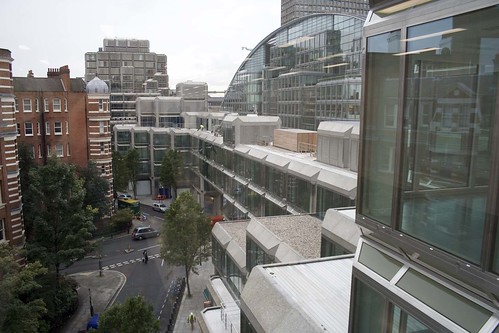
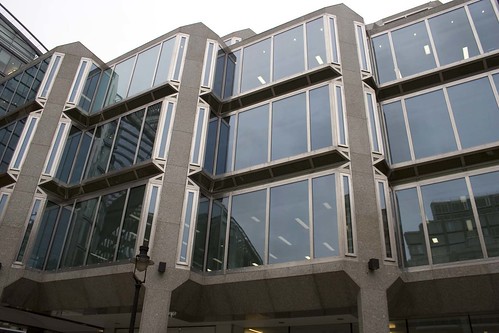
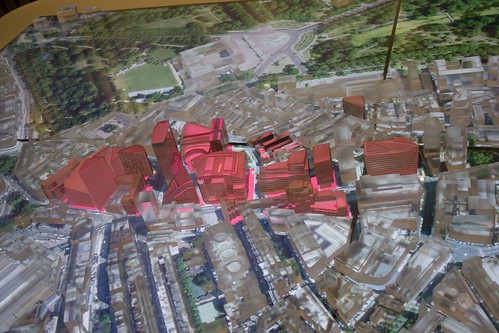






Whereas at Allington House up the road, Land Securities are planning to demolish the building and destroy the endangered species sculptures by Barry Baldwin – http://www.peterberthoud.co.uk/2012/10/endangered-species-under-threat-victoria/
This sort of building are common in the UK given that regulation in tall building construction are quite restricted. An alternative to cover the need of space is to build long projects such as the one shown above.